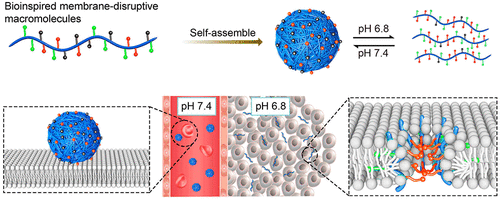当前位置:
X-MOL 学术
›
ACS Appl. Bio Mater.
›
论文详情
Our official English website, www.x-mol.net, welcomes your feedback! (Note: you will need to create a separate account there.)
Bioinspired Membrane-Disruptive Macromolecules as Drug-Free Therapeutics
ACS Applied Bio Materials ( IF 4.7 ) Pub Date : 2020-01-21 , DOI: 10.1021/acsabm.9b01143 Feng Fan , Ji-Gang Piao , Yangyang Zhao , Lijun Jin , Mingyang Li , Yucai Wang , Lihua Yang
ACS Applied Bio Materials ( IF 4.7 ) Pub Date : 2020-01-21 , DOI: 10.1021/acsabm.9b01143 Feng Fan , Ji-Gang Piao , Yangyang Zhao , Lijun Jin , Mingyang Li , Yucai Wang , Lihua Yang

|
Membrane-disruptive, drug-free macromolecular therapeutics may help overcome cancer drug-resistance. Their inability to distinguish cancerous from normal cells, however, results in significant off-target toxicity. Note that the tumor has a slightly acidic microenvironment (pH 6.5–6.8) in contrast to the alkaline microenvironment in normal tissues (pH 7.4) and that host-defense peptides (HDPs) and their synthetic mimetics need to be net cationic to be membrane-disruptive. We herein endow polymer mimetics of HDPs with acid-triggered cationicity, to make them membrane-disruptive at only tumor pH. For these polymer mimetics, there exists a maximal threshold of chain length that determines whether the micelle of a mimetic inherits its pH-sensitive activity. Using the most and least active micelles as representatives, we find that their distinct potency in disrupting membranes arises because of their striking tendency to dissociate upon exposure to tumor pH. As expected, these micelles exhibit in vitro cytotoxicity profiles that correlate with their membrane-disruptive activity profiles. When administered intravenously, these micelles—irrespective of their distinct activity profiles—unanimously exhibit long systemic circulation as do PEGylated micelle nanoparticles, despite of their lacking stealth materials, owing to the zwitterionic nature of their surfaces at blood pH. Nevertheless, the pH-sensitive micelle achieves significantly higher tumor uptake and strikingly better therapeutic efficacy than its completely inactive analogue. More important, the pH-sensitive micelle exhibits undetectable off-target toxicity, owing to its pH-sensitivity. Clearly, making HDPs and their mimetics sensitive to tumor-characteristic cues (e.g., acidic pH) is efficient in minimizing their off-target toxicity, thereby offering membrane-disruptive, drug-free macromolecular therapeutics for fighting against cancer drug-resistance.
中文翻译:

仿生膜破坏性大分子作为无药物疗法
膜破坏性、无药物的大分子疗法可能有助于克服癌症的耐药性。然而,它们无法区分癌细胞和正常细胞,导致显着的脱靶毒性。请注意,与正常组织中的碱性微环境(pH 7.4)相比,肿瘤具有微酸性微环境(pH 6.5-6.8),并且宿主防御肽(HDP)及其合成模拟物需要是净阳离子才能成为膜-破坏性的。我们在此赋予 HDP 的聚合物模拟物酸引发的阳离子性,使其仅在肿瘤 pH 值下具有膜破坏性。对于这些聚合物模拟物,存在决定模拟物胶束是否继承其 pH 敏感活性的最大链长阈值。以最活跃和最不活跃的胶束为代表,我们发现它们在破坏膜方面的独特效力是因为它们在暴露于肿瘤 pH 值时具有明显的解离倾向。正如预期的那样,这些胶束表现出与它们的膜破坏活性谱相关的体外细胞毒性谱。当静脉内给药时,这些胶束(无论其不同的活性特征如何)都与聚乙二醇化胶束纳米颗粒一样表现出较长的全身循环,尽管它们缺乏隐形材料,因为它们的表面在血液 pH 值下具有两性离子性质。然而,与完全无活性的类似物相比,pH 敏感胶束实现了显着更高的肿瘤吸收和显着更好的治疗效果。更重要的是,由于其 pH 敏感性,pH 敏感胶束表现出不可检测的脱靶毒性。清楚地,
更新日期:2020-01-22
中文翻译:

仿生膜破坏性大分子作为无药物疗法
膜破坏性、无药物的大分子疗法可能有助于克服癌症的耐药性。然而,它们无法区分癌细胞和正常细胞,导致显着的脱靶毒性。请注意,与正常组织中的碱性微环境(pH 7.4)相比,肿瘤具有微酸性微环境(pH 6.5-6.8),并且宿主防御肽(HDP)及其合成模拟物需要是净阳离子才能成为膜-破坏性的。我们在此赋予 HDP 的聚合物模拟物酸引发的阳离子性,使其仅在肿瘤 pH 值下具有膜破坏性。对于这些聚合物模拟物,存在决定模拟物胶束是否继承其 pH 敏感活性的最大链长阈值。以最活跃和最不活跃的胶束为代表,我们发现它们在破坏膜方面的独特效力是因为它们在暴露于肿瘤 pH 值时具有明显的解离倾向。正如预期的那样,这些胶束表现出与它们的膜破坏活性谱相关的体外细胞毒性谱。当静脉内给药时,这些胶束(无论其不同的活性特征如何)都与聚乙二醇化胶束纳米颗粒一样表现出较长的全身循环,尽管它们缺乏隐形材料,因为它们的表面在血液 pH 值下具有两性离子性质。然而,与完全无活性的类似物相比,pH 敏感胶束实现了显着更高的肿瘤吸收和显着更好的治疗效果。更重要的是,由于其 pH 敏感性,pH 敏感胶束表现出不可检测的脱靶毒性。清楚地,



























 京公网安备 11010802027423号
京公网安备 11010802027423号